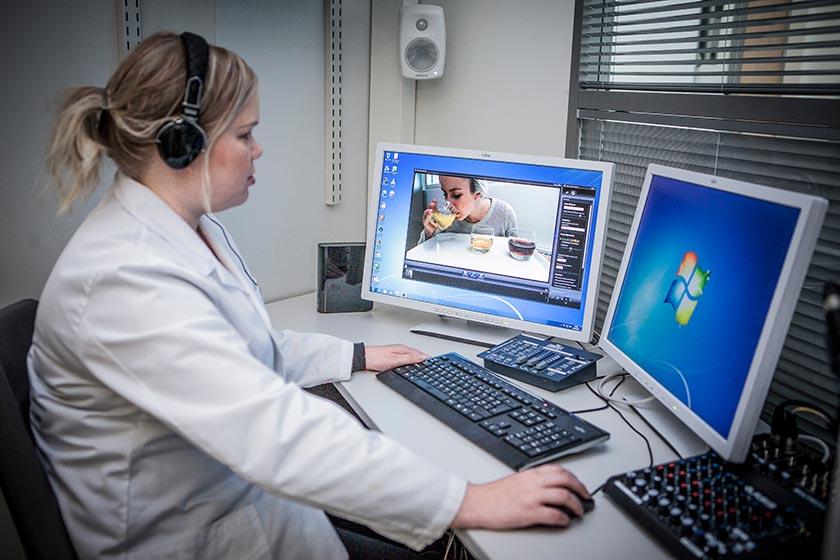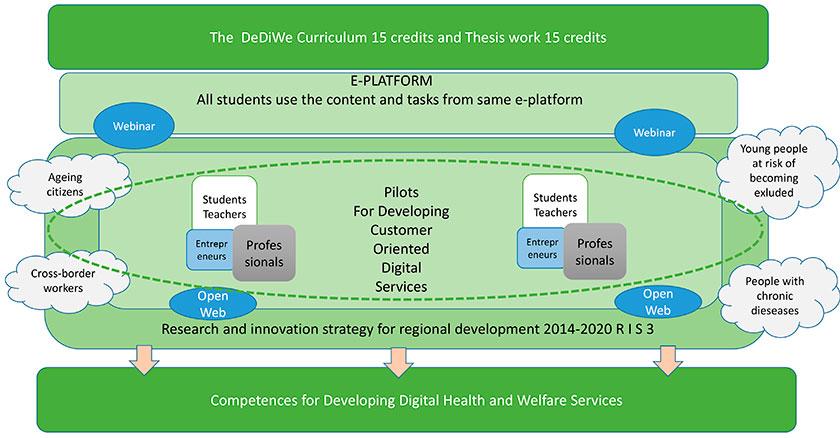
Photo: Savonia UAS
The healthcare systems in Europe are facing new challenges such as ageing of the population, increased budgetary pressure and thereby there is a need for cost-efficient solutions. e and mHealth could be one way to tackle these challenges by contributing to a more patient-focused healthcare. (European Commission, 2014,2015a). Eysenbach defines eHealth as follows (2001): “e-health is an emerging field in the intersection of medical informatics, public health and business, referring to health services and information delivered or enhanced through the Internet and related technologies. In a broader sense, the term characterizes not only a technical development, but also a state-of-mind, a way of thinking, an attitude, and a commitment for networked, global thinking, to improve health care locally, regionally, and worldwide by using information and communication technology.”
As the Digital Agenda for Europe states, challenges can be found in insufficient skills and motivation of the health care personnel to take part in the digital world (European Commission, 2015b). Research shows that continuous evaluation of information and competence is needed in health care education. The minimum competence requirements needed for health care professionals in the future are: the informatics knowledge base, informatics tools adoption and nursing and health information integration management. (Rajalahti, 2014)
The project “The Developer of Digital Health and Welfare Services” is a multi-cultural and multi-professional project that aims to create a new curriculum giving future professionals skills in developing improved eHealth and welfare services for citizens. The project is founded by Central Baltic. The partners are from Estonia, Latvia and Finland.
The project starts by evaluating the current curriculums to find the current knowledge about developing eHealth and welfare services.
In the second phase the project creates the new 30 ECTS curriculum. The curriculum is inspired by the recommendations of the International Medical Informatics Association (Mantas et al, 2010, 2011), The TIGER Initiative (2009) and the article Designing a Modern IT Curriculum (Westerlund & Pulkkis, 2015). Also the European Computer Driving License is defining skills all professionals´ already should have on a bachelor lever (EDCL, 2015).
[easy-tweet tweet=”Research shows that continuous evaluation of information and competence is needed in health care education. ” hashtags=”uasjournal, digitalization”]
The content of the new curriculum is based on measured competency and the latest multi-professional knowledge about the needs of the digital society. (eHealth Action Plan 2012, STM 2014, Finnish Nursing Association 2016.) In the study unit, future professionals ( in IT, economics, social- and health care) are developing their current competencies to match the needs of digital health care and welfare, taking into account the professional qualifications defined in EQF levels 5-6 as well as cultural differences in the Central Baltic region (Recommendation of the EU, 2008).
The curriculum will be based on the Learning by Developing (LbD) pedagogical model, developed in Laurea University of Applied Sciences (UAS) (Raij, 2007) In the LbD model, the goal is to bring about real changes in the world and new ways to act (Taatila & Raij, 2012). Combining theoretical and practical knowledge (Nonaka & Takeuchi, 1995) in the UAS´s projects means having knowledge in practice, of practice and for practice, and generating new innovations (Raij, 2007). Students, teachers, working life professionals and customers work together in real working life related research and development projects. The outcomes are innovations and new partner’s competences with regional actors. (Ahonen, Meristö, Ranta & Tuohimaa, 2014.)
The partners arrange a study unit piloting the curriculum. The students’ eHealth related competency is measured at the beginning and after the pilot. The curriculum, which is built on an e-learning platform, is piloted in Finnish (2), Estonian and Latvian VET/UAS programmes. The students (20×4) in the pilot get excellent competence and skills in designing and creating eHealth services in an international co-operation. Webinars and seminars support the studies. Training periods are also possible. The themes of the development projects are ageing citizens, cross-border workers, young people at risk of becoming excluded and people with chronic diseases. The Structure of DeDiWe project is described in the figure one.

It is important for the students to learn current core competencies and skills of their vocational subjects, but it is equally important to be a competent innovator and developer.
The new 30 ECTS study module is built around three main themes of 5 ECTS each; the client, the environment and the development of digital activities. These 15 ECTS can then be combined with 15 ECTS thesis or project work with working life partners.
The project not only creates a new curriculum but also gives the students the possibilities to implement development projects that are useful for the citizens. The core curriculum is the same for all students, which allows for a variety of professionals to work together. The level of the learning outcomes, as the starting level in the different modules, partly differ between professionals and to secure the possibility for all to develop the learning assignments are designed considering this. Each partner has its own set of students, but since they work in the same e-learning environment, cooperation is easy, regardless of country or organization.
The knowledge is viewed in three different ways: in, of and for practice. The new curriculum promotes multi-professional studying with the LbD – model, which gives students excellent opportunities to learn in real working life projects – and innovate new services to eHealth and welfare services.
Writers
Outi Ahonen, MNSc, Senior Lecturer, Laurea University of Applied Science outi.ahonen(at)laurea.fi
Gun-Britt Lejonqvist, LHSc, Principla lecturer, Arcada University of Applied Sciences, gun-britt.lejonqvist(at)arcada.fi
Baiba Apkalna, Mg.sc.hum., Project expert, Red Cross Medical College of Riga Stradins University, baiba.apkalna(at)rcmc.lv
Kersti Viitkar, MNSc, Coordinator of Nursing and Midwifery Curricula, Tartu Health Care College, kerstiviitkar(at)nooruse.ee
[vc_tta_accordion active_section=”0″ no_fill=”true” el_class=”lahteet”][vc_tta_section title=”References” tab_id=”1458134585005-b3f22396-5506″]
Ahonen, O., Meristö, T., Ranta, L. &. Tuohimaa, H. 2014. Project as a Patchwork Quilt –from Study Units to Regional Development. In K. Raij (Ed.), Learning by Developing Action Model (67-84) Helsinki, Laurea University of Applied Science. Retrieved January 7 2016, from http://ecahe.eu/assets/uploads/2015/06/36-Raij-LbD-Action-Model.pdf
eHealth Action Plan 2012-2020. 2012. Innovative healthcare for the 21st century6.12.2012. COM(2012) 736 final, Brussels. Retrieved January 11 2016 , from https://ec.europa.eu/digital-agenda/en/news/ehealth-action-plan-2012-2020-innovative-healthcare-21st-century
European Commission. 2014. GREEN PAPER on mobile Health (“mHealth”). SWD(2014) 135 Final. Brussels. Retrieved January 11 2016, from https://ec.europa.eu/digital-agenda/en/news/green-paper-mobile-health-mhealth
European Commission. 2015a. eHealth. Retrieved January 11 2016, from http://ec.europa.eu/health/ehealth/policy/index_en.htm
European Commission. 2015b. Digital Agenda for Europe A Europe 2020 Initiative. Retrieved January 12 2016, from https://ec.europa.eu/digital-agenda/en/digital-europe
EDCL, European Computer Driving License. 2015. Retrieved January 2016 from http://www.ecdl.org/programmes/index.jsp?p=108&n=2927
Eysenbach G. 2001. What is e-health? Journal of Medical Internet Research , 3(2): e20. Published online 2001 Jun 18. doi: 10.2196/jmir.3.2.e20. Retrieved January 12 2016, from http://www.jmir.org/2001/2/e20/
Finnsih Nursing Association. 2016. Strategy for eHealth. Retrieved January 13 2016, from https://sairaanhoitajat.fi/wpcontent/uploads/2016/01/S%C3%84HK%C3%96ISET_TERVPALV_STRATEGIA.pdf
Mantas, J., Ammenwerth, E., Dermis, G., Hasman, A., Haux, R.,Hersh, W., Hovenga, E., Lun, KC. Marin, H. Martin-Sanchez, F. ja Wrighr G. 2010. Recommendations of the International Medical Informatics Association (IMIA) on Education in Biomedical and Health Informatics. International Medical Informatics Association, Working Group on Health and Medical Informatics Education. IMIA Educational Recommendations-Revised.
Mantas, J., Ammenwerth, E., Dermis, G., Hasman, A., Haux, R.,Hersh, W., Hovenga, E., Lun, KC. Marin, H. Martin-Sanchez, F. ja Wrighr G. 2011. Recommendations of the International Medical Informatics Association (IMIA) on Education in Biomedical and Health Informatics -First Revision. European Journal for Biomedical. Informatics, 7(1), 3-18.
Nonaka, I. & Takeuchi, H. 1995. The knowledge-creating company. How Japanese companies create the dynamics of innovation. New York, Oxford University Press.
Raij, K. 2007. Learning by developing. Laurea Publications A-58. Laurea University of Applied Sciences.
Rajalahti, E. 2014. The development of health educators’ nursing informatics competence. Faculty of Social Sciences and Business Studies. Dissertations in Social Sciences and Business Studies, no 89. 2014.Publications of the University of Eastern Finland. University of Eastern Finland, Kuopio. Available from, http://epublications.uef.fi/pub/urn_isbn_978-952-61-1611-2/urn_isbn_978-952-61-1611-2.pdf
Recommendation of the European Parliament and of the Council of 23 April 2008 on the establishment of the European Qualifications Framework for lifelong learning, Annex II. 2008. Retrieved January 12 2016, from http://www.ond.vlaanderen.be/hogeronderwijs/bologna/news/EQF_EN.pdf
STM. 2014. TIETO HYVINVOINNIN JA UUDISTUVIEN PALVELUJEN TUKENA. Sote-tieto hyötykäyttöön–strategia. Retrieved January 12 2016, from http://stm.fi/julkaisu?pubid=10024/125500
Taatila, V. & Raij, K. 2012. Philosophical review of pragmatism as a basis for learning by developing pedagogy. Educational Philosophy and Theory 44(8) .doi: 10.1111/j.1469-5812.2011.00758.x
TIGER Initiative, Technology Informatics Guiding Education Reform 2009: Informatics Competencies for Every Practicing Nurse: Recommendations from the TIGER Collaborative. 2009. Retrieved January 14 2016, from http://www.thetigerinitiative.org/
Westerlund M, Pulkkis G. 2015. Designing a Modern IT Curriculum: Including Information Analytics as a Core Knowledge Area. Paper presented at the 17th Australasian Computing Education Conference (ACE2015), Sydney, Australia, January 2015. Conferences in Research and Practice in Information Technology (CRPIT), Vol. 160. D’Souza,D. & Falkner,K. (Eds.)
[/vc_tta_section][/vc_tta_accordion]



